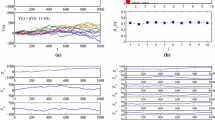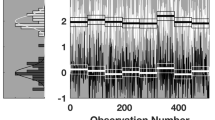Abstract
Explored several procedural questions in the use of the principal components technique for filtering time series data and reconstructing attractors in two or more dimensions. Data originated from an earlier study on work flows in experimental hierarchical organizations. The reconstructed time series and attractors were evaluated alongside a nonlinear regression modeling approach for assessing the dynamical properties of data. The results showed that, if the nonlinear function representing the time series is initially poorly fitted, principal components filtering will probably help to identify a nonlinear structure insofar as it has been fed enough data to capture the complexity of the time series of events. The relative merits of the eigenvalue 1.00 criterion and the scree test for determining the correct number of components were also addressed. Oblique rotation procedures are recommended.
Similar content being viewed by others
REFERENCES
Abarbanel, H. D. I. (1996). Analysis of chaotic data. New York: Springer-Verlag.
Abarbanel, H. D. I., Brown, R., Sidorowich, J. J., & Tsimring, L. S. T. (1993). The analysis of observed chaotic data in physical systems. Reviews of Modern Physics, 65, 1331–1392.
Cattell, R. B. (1966). The scree test for the number of factors. Multivariate Behavioral Research, 1, 245–276.
Fabrigar, L. R., Wegener, D. T., MacCallum, R. C., & Strahan, E. G. (1999). Evaluating the use of exploratory factor analysis in psychological research. Psychological Methods, 4, 272–299.
Ferro Milone, F., Minelli, T. A., & Turicchia, L. (1998). Neuron synchronization and human EEG phenomenology simulation. Nonlinear Dynamics, Psychology, and Life Sciences, 2, 21–34.
Guastello, S. J. (1992). Clash of the paradigms: A critique of an examination of the polynomial regression technique for evaluating catastrophe theory hypotheses. Psychological Bulletin, 111, 375–379.
Guastello, S. J. (1995). Chaos, catastrophe, and human affairs. Mahwah, NJ: Lawrence Erlbaum Associates.
Guastello, S. J. (1998). Creative problem solving groups at the edge of chaos. Journal of Creative Behavior, 32, 38–57.
Guastello, S. J. (1999). Hierarchical dynamics affecting work performance in organizations. In. J-P. Dauwalder and W. Tschacher (Eds.), Dynamics, synergetics, and autonomous agents (pp. 290–311). Singapore: World Scientific.
Guastello, S. J., & Guastello, D. D. (1998). Origins of coordination and team effectiveness: A perspective from game theory and nonlinear dynamics. Journal of Applied Psychology, 83, 423–437.
Guastello, S. J., & Johnson E. A. (1999). The effect of downsizing on hierarchical work flow dynamics. Nonlinear Dynamics, Psychology, and Life Sciences, 3, 347–377.
Guastello, S. J., Johnson E. A., & Rieke, M. L. (1999). Nonlinear dynamics of motivational flow. Nonlinear Dynamics, Psychology, and Life Sciences, 3, 259–274.
Guastello, S. J. & Philippe, P. (1997). Dynamics in the development of large information exchange groups and virtual communities. Nonlinear Dynamics, Psychology, and Life Sciences, 1, 123–149.
Johnson, T. L., & Dooley, K. (1996). Looking for chaos in time series data. In W. Sulis & A. Combs (Eds.), Nonlinear dynamics in human behaviour (pp. 44–76). Singapore: World Scientific.
Kanz, H., & Schreiber, T. (1997). Nonlinear time series analysis. New York: Cambridge University Press.
Kaplan, D., & Glass, L. (1995). Understanding nonlinear dynamics. NewYork: Springer-Verlag.
Lange, R. (1999). A cusp catastrophe approach to the prediction of temporal patterns in the kill dates of individual serial murderers. Nonlinear Dynamics, Psychology, and Life Sciences, 3, 143–160.
Packard, N. H., Crutchfield, J. P., Farmer, J. D., & Shaw, R. S. (1980). Geometry from a time series. Physical Review Letters, 45, 712–716.
Rummel, R. J. (1970). Applied factor analysis. Evanston, IL: Northwestern University Press.
Stewart, H. B. (1996). Chaos, dynamical structure and climate variability. In D. E. Herbert (Ed.), Chaos and the changing nature of science and medicine (pp. 80–114). Woodbury, NY: American Institute of Physics.
Tabachnick, B. G., & Fidell, L. S. (1989). Using multivariate statistics (2nd. ed.). New York: Harper & Row.
Torgerson, W. (1959). Theory and methods of scaling. New York: Wiley.
Wiggins, S. (1988). Global bifurcations and chaos. New York: Springer-Verlag.
Rights and permissions
About this article
Cite this article
Guastello, S.J., Bock, B.R. Attractor Reconstruction with Principal Components Analysis: Application to Work Flows in Hierarchical Organizations. Nonlinear Dynamics Psychol Life Sci 5, 175–191 (2001). https://doi.org/10.1023/A:1026471501949
Issue Date:
DOI: https://doi.org/10.1023/A:1026471501949




